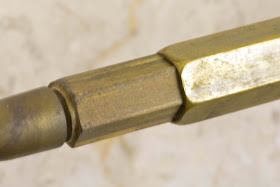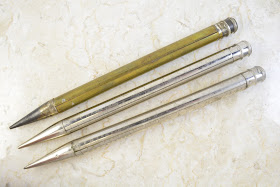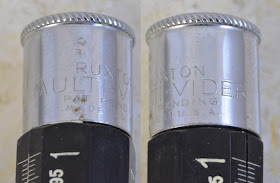This article has been edited and included in The Leadhead's Pencil Blog Volume 4; copies are available print on demand through Amazon here, and I offer an ebook version in pdf format at the Legendary Lead Company here.
If you don't want the book but you enjoy this article, please consider supporting the Blog project here.
I’m having a hard time writing this. It’s not because I don’t know which pencils I’m going to write about – that’s coming in a minute. It’s because the title of the article has gotten into my head.
When I started this blog, the idea was to use it as an update service for the people who bought my book,
The Catalogue of American Mechanical Pencils, a book weighing in at 178 pages. The blog is about 1,200 pages of manuscript, and I still think I could continue writing indefinitely.
Well, sort of. The problem is, I don’t want to right now. I’ve taken breaks from the blog here before – to write
American Writing Instrument Patents 1799-1910, then to write
American Writing Instrument Patents Volume 2: 1911-1945 . . . then to edit
The Pennant. I’ve finally learned it isn’t really a “break” if I’m just going off to work on something else for awhile.
So this time I’m going to take a break to ask myself what I
want to do right now. I’ve got a pile of projects I’ve been trying to get around to writing, some pencil-related, most not. Maybe I’ll pick one of those up. Then again, maybe I’ll sleep in a little later in the mornings for awhile.
I’m sure I won’t be able to resist coming back and posting once in awhile, but in the meantime, I wanted to leave you -- for now -- with something
special. After I sized up a vast library of photographs I’ve taken over the last five years and scraps of research, looking for the perfect subject for the millennial post, one stood head and shoulders over all others:
This pile of stuff showed up, all in one lot, listed in an online auction titled “RUXTON MULTI-VIDER MECHANICAL PENCIL/SLIDERULE LOT PROTOTYPES,EPHEMERA,SAMPLES” in April, 2014. No fewer than six of my friends emailed me in the first few hours after it was listed to tell me to look at it, and it was already on my radar. Chase it to the end, I did. Pay through the nose, I did. Regret it, though, I did not.
The lettering inside the box lids is a little tough to read:
“Ruxton MULTI-VIDER Pencil / Multiplies - Divides / Pat. Apld. For.” Ruxton Multi-Viders are a cult classic among pencil collectors, and finding one in any condition is usually a cause for celebration. Two mint boxed examples? That should draw a “holy cow” from even the most grizzled collector:
Ruxtons were combination slide rule/mechanical pencils operated by pulling the crown and the tip to slide the two halves of the barrel. Internally, these two examples are a little different:
I posted an article about the Ruxton here four years ago at
http://leadheadpencils.blogspot.com/2012/09/the-ruxton-multi-vider.html. Not much has been written about the Ruxtons, and my rudimentary article four years ago is still one of the top search results on the subject. We know they were patented in Great Britain on an application filed on January 21, 1929 and granted February 20, 1930 as number 325,327.
The named patentees in the England were A. Gahagan and Wall Street tycoon W. V. C. Ruxton (see my previous article for the story behind him); for whatever reason, the patent was apparently never issued in the United States. The earliest advertisements I could find were from December, 1928. Here’s one, as printed in
Boys’ Life:
Advertisements continued through 1929, in
Popular Science and
Popular Mechanics, with the last magazine advertisements I could find dating to September, 1929:
The stock market crashed in October, 1929, and the absence of advertising after then has suggested that the Ruxton Multi-Vider was an early casualty of what would become the Great Depression. There’s only one documented piece of literature concerning the pencil which might have been published after then – a Christmas brochure attributed to late 1929 and published at
http://retrocalculators.com/ruxton.htm, a website dedicated to slide rules and calculating machines.
There was one of these brochures included in this lot of Ruxton materials. Here it is, published in its entirety – including the cover page, which says the Ruxton is “the gift for 1929” and provides the source for the 1929 attribution. Maybe 1929 – but it could also have been for 1928 (as in, the gift for the coming year, not the present one):
There was also a great tri-fold brochure in this lot; while it is undated, I’m sure it was printed prior to the crash of 1929, since one of the advertised uses for the pencil is for “calculating stock yields”:
This lot of Ruxton materials, though, contains the first evidence of life after ‘29 for the brand. Have a look at this curious piece of letterhead:
Compared with the cover page of that ‘28 or ‘29 Christmas brochure:
The Ruxton Multi-Vider Corporation from the Greybar Building in New York was succeeded by Leonard G. Yoder, proprietor of the Multi-Vider. According to this, Yoder maintained an office in New York, at 252 Lafayette Street, but the “factory and office” of the company was located at 140 North Market Street, East Palestine, Ohio:
Here’s another clue: a printers block made for newspaper advertisements, which references the “Multi-Vider” and “Yoder Instruments” of East Palestine, Ohio:
I can’t find any instance of a published advertisement using this block. Yoder Instruments made a wide variety of mathematical and scientific instruments, including Grove’s Moto-Math set, introduced in 1947, and surveyors’ sextants. The sextants seem to have been produced in the greatest quantity, given the large number which have survived. This advertisement for telescopes, printed in 1957, indicates that Yoder Instruments had been “Instrument Manufacturers Since 1930" – dead on if Leonard G. Yoder took over production of the Multi-Vider on his own account after 1929.
Yoder died in 1977, and his obituary indicates he was survived by two daughters, Katherine and Anna.
Anna lived in Rockville, Tennessee: I contacted the ebay seller of this lot after the auction closed to ask where it came from, and the seller – the owner of an antique mall near Rockville – said some people came in who were cleaning out a house in Rockville and sold her the whole box. She couldn’t (or more likely wouldn’t, after she did so well on the lot I purchased from her) tell me who they were or whether there were other documents or items of historical value still in that house.
My next step was to track down Katherine, who still lives in East Palestine, close to 140 North Market Street. She was very young in 1930, but she does remember that her father made slide rule pencils for some English chaps . . . she doesn’t remember who and she wasn’t aware of any surviving documents. She was, however, able to confirm one important detail: that her sister in Tennessee had whatever was left of her father’s pencil operations, and the box I acquired was from Leonard G. Yoder.
That’s provenance. And that’s what makes the rest of the items that were in this lot particularly exciting:
I don’t believe that Leonard Yoder and Yoder Instruments started making the Multi-Vider in 1930. Katherine remembers her father making pencils for some Englishmen: the Multi-Vider was patented not in the U.S., but in England – and all known examples were made in the United States. In addition, had Yoder bought the company at the end of 1929, he would have acquired all of the tooling, parts and designs already being manufactured and there would have been no need to reinvent the wheel. When Yoder Instruments advertisements indicate the company was established in 1930, I believe that means that Mr. Yoder, who had been manufacturing these pencils for the Ruxton Multi-Vider Corporation since 1928 or so, set up his own company to continue making them after Ruxton itself perished.
So what you are about to see are, beyond any question in my mind, are the original shop models and prototypes for the Ruxton Multi-Vider.
These three were wood and ebonite shop pieces testing different ways to make the barrel halves slide:
Note that the top example has what is left of a paper label glued to its surface, calibrated to test how the slide rule function would operate in practice:
Here are a few plain brass rods, used to test machined engraving:
One rod has incomplete engraving or stamping:
There were a couple of dies thrown in with the lot – note that the one on the right has what looks like exactly this same incomplete engraving:
Also included were two pieces of cardboard marked with Multi-Vider calibrations. They might have been intended as gauges against which to check imprinted barrels for accuracy:
Here are three experimental, all-metal pencils, testing different means of telescoping actions:
The top example most closely resembles the production Ruxtons, and it is calibrated on the barrel . . . but without numbers:
The hexagonal one has four facets which telescope out over the end of the pencil:
Revealing that it is built around an ordinary barrel of a wooden pencil:
The dents on the nozzle of that third example, fitted with a large ball clip, were there when this arrived to me. They were likely put there by Leonard himself, who must have been frustrated after it was assembled to find out how difficult it was to pull apart again. With quite a bit of wrestling – using rubber bands to grip it rather than a pair of pliers – I was able to extend it a bit:
This next grouping of ebonite shop models is really interesting. These illustrate how the slider function found on production Ruxtons is approaching its final form, as the unmarked top example indicates:
The clip should look familiar: it’s taken from an oversized Autopoint – identical clips were available on production Autopoints in 1927. Instead of the hex bolt, however, these clips were secured with flathead screws:
Only the bottom example is calibrated with numbers, but look closely: those numbers are hand-engraved, not machined:
Next are three fully functional, all-metal Multi-Vider prototypes; the top example is made of brass with a cap and tip that are tarnished like silver, while the other two appear to be all chrome-plated steel:
Also included in this lot were five production Ruxtons:
Three of these appear to be regular production models – black and the black/maroon combination being the most common. The white example is in very rough condition, with plastic that has shrunk, warped, cracked and interfered with the sliding action – possibly a customer return, since it is engraved with a name. What’s unusual about it is that it is marked not on the barrel, but with an imprint at the top, something I hadn’t seen before:
There’s one other example in this group with that feature – the one with a shorter cap I haven’t seen on a Ruxton:
Finally, I’ve got one last thing to show you that came with all this, which gives you a sense of what might have been. Included was a ragged cardboard box with metal reinforced corners, marked “MV Samples” on one end:
Inside of which was a smaller box:
Filled with Ruxton barrels molded in different colors:
Can you imagine trying to read the numbers on a Ruxton made from this?



























































